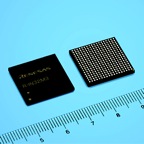 Industrial Ethernet (IE) refers to the use of the Ethernet family of computer network technologies in an industrial environment, for automation and process control. It is an open industrial networking standard that takes advantage of commercial, off-the-shelf Ethernet communication chips and physical media. Ethernet/IP technology has evolved due to the high demand for Ethernet control applications. This standard also stems from the control industries’ need for interoperability among various Ethernet control products.
Industrial Ethernet (IE) refers to the use of the Ethernet family of computer network technologies in an industrial environment, for automation and process control. It is an open industrial networking standard that takes advantage of commercial, off-the-shelf Ethernet communication chips and physical media. Ethernet/IP technology has evolved due to the high demand for Ethernet control applications. This standard also stems from the control industries’ need for interoperability among various Ethernet control products.
How does it work?
A number of techniques are used to adapt Ethernet for the needs of industrial processes, which require real time behaviour. By using standard Ethernet, automation systems from different manufacturers can be interconnected throughout a process plant. Industrial Ethernet takes advantage of the relatively larger marketplace for computer interconnections using Ethernet to reduce cost and improve performance of communications between industrial controllers.
The hardware in the new R-IN32M3 series covers heavy load operations for the CPU, the combination of the CPU and integrated real-time OS off load engine results in ultra-high-speed real-time responsiveness, which is said to be faster than the conventional software real-time OS. In addition, the fluctuation caused by inconsistencies in the operation time with conventional CPU processing is reported to be reduced, substantially, from one-fifth to one-tenth of the previous level. The new R-IN32M3 series includes an integrated ARM Cortex-M3 CPU (100 MHz). The new Ethernet controllers accept protocols for industrial Ethernet communication such as CC-Link IE and EtherCAT and will accept the control area network (CAN) which is heavily used in industries and generic interface such as universal asynchronous receiver transmitter (UART).
[stextbox id=”info”]
Advantages:
• Increased speed, up from 9.6 kbit/s with RS-232 to 1 Gbit/s with Gigabit Ethernet.
• Increased distance
• Ability to use standard access points, routers, switches, hubs, cables and optical fiber.
• Ability to have more than two nodes on link, which was possible with RS-485 but not with RS-232.
• Peer-to-peer architectures may replace master-slave ones.
• Better interoperability.
Disadvantages:
• Migrating existing systems to a new protocol.
• Real-time uses may suffer for protocols using TCP.
• Managing a whole TCP/IP stack is more complex than just receiving serial data.
• The minimum Ethernet frame size is 64 bytes, while typical industrial communication data sizes can be closer to 1-8 bytes.
[/stextbox]
Interesting features of the R-IN32M3 Series
The R-IN32M3-CL, which implements the CC-Link IE protocol in hardware, incorporates a 1 Gbps Ethernet MAC, so 1 Gbps Ethernet communication is said to be achieved by adding an external 1 Gbps EtherPHY.
Industrial Ethernet communication applications require support for a large number of tasks, high-speed time synchronisation, and low power consumption. By implementing real-time OS processing in hardware, which previously imposed a substantial load on the CPU, and standard Ethernet communication protocol processing such as checksum calculation and header sorting, processing speed is increased many times.
The R-IN32M3-CL with CC-Link IE support integrates a slave controller supporting CC-Link IE Field as a circuit. The R-IN32M3-EC with EtherCAT support, on the other hand, integrates a slave controller supporting the EtherCAT industrial Ethernet communication standard. Both feature an ARM Cortex-M3 (100 MHz) 32-bit RISC CPU, a media access control (MAC) with low-latency 2-port switch function required by industrial Ethernet protocols, and large on-chip memory. In addition to communication interfaces with industrial Ethernet support, communication interfaces such as CC-Link, CAN, serial peripheral interface (SPI), and UART can be implemented as well, allowing the chip to be used as gateway modules to an industrial Ethernet network.
Pricing and Availability
Renesas mentions in their press release that samples of the first products will be available in January 2013, and would be priced at US$25 per unit. Please note that pricing and availability are subject to change without notice.






